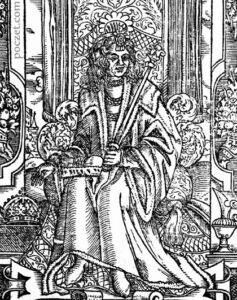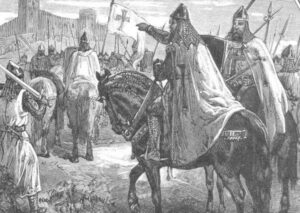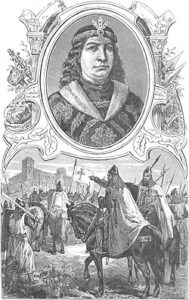History has known many princes who perished in battle or were betrayed by the powerful. But the death of Władysław Spindleshanks stands out. He died at the hands of a woman, under surprising and murky circumstances. What really happened?
An Ambitious Piast Ruler
Władysław Spindleshanks was the grandson of Bolesław III Wrymouth and the youngest son of Duke Mieszko III the Old of Greater Poland. His exact birth date remains unknown, but it is generally accepted that he was born no later than 1166. The nickname „Laskonogi” („Spindleshanks”) first appeared in the „Greater Poland Chronicle”, authored by an anonymous medieval writer. The origin of the epithet remains unclear, although late-medieval chroniclers suggested it referred to the duke’s long and slender legs.
The son of Mieszko the Old had a difficult childhood. Along with his father and mother, Eudoxia of Ruthenia, he spent many years wandering in exile. During this time, he visited Bohemia, the Holy Roman Empire, and Western Pomerania. Notably, toward the end of his life, he was once again forced into exile, though this time his wanderings were confined to lands traditionally ruled by the Piasts.
Historians consider Spindleshanks an exceedingly ambitious ruler, relentlessly striving toward his goals – sometimes at the expense of morality. In a conflict with Archbishop Henryk Kietlicz of Gniezno, he plundered the monastery at Mogilno and expelled its monks. And this was not an isolated example of his highhandedness. Yet, within the context of his era, such behavior was not particularly exceptional.

Władysław spent much of his life waging war, although he was by no means a skilled commander. For many years, he fought his nephew, Władysław Odonic, Duke of Kalisz, over control of Greater Poland. He also made determined efforts to seize Cracow, briefly occupying the city twice. He last took Cracow in 1228, just three years before his death.
Final Struggles
His joy at gaining Cracow was short-lived. He was soon expelled from Greater Poland by his unrelenting nephew. The “Greater Poland Chronicle” records this event under the year 1229. Scholars believe that Odonic was aided by Conrad of Masovia, who had his own aspirations to the throne of Cracow. With enemies closing in from both sides, Spindleshanks stood little chance. Perhaps if he had discerned their intentions earlier, he could have mounted some resistance. But the lack of such an attempt suggests he was taken by surprise, leading to his swift downfall.
After his expulsion, he found refuge at the court of his ally, Henry I the Bearded of Silesia. Following the death of Duke Casimir of Opole in May 1230, Henry installed Spindleshanks in Racibórz. Around the same time, with the consent of Cracow’s nobles, Władysław agreed to hand over the city to Henry, who ruled it as governor. Within a short span, Spindleshanks’s fortunes had declined drastically. Now an exile, he was effectively powerless and dependent on both allies and adversaries. In Greater Poland, he was still supported by noble families such as the Nałęcz, Niałka, Leszczyc, Junosza, and Awdaniec clans, while Odonic enjoyed the backing of the Zaremba, Grzymała, Oksza, and Poraj lineages.

The fate of Greater Poland would ultimately be decided by war. According to reliable sources, Spindleshanks launched a campaign in early spring of 1231 to reclaim his patrimony from his hated nephew. It’s possible that Henry the Bearded supported him, though direct evidence is lacking. Still, it seems unlikely that the Silesian duke would have been indifferent to the ambitions of a former prince living under his protection. Their prior relations had been amicable, sometimes even close, which in those days often translated into mutual military support. It’s reasonable to believe that such cooperation continued in 1231.
The exact course and conclusion of this campaign remain unknown. The “Greater Poland Chronicle”, written around the turn of the 14th century, claims that Spindleshanks laid siege to Gniezno in vain and died in exile later that year. However, modern historians challenge this account, arguing that he temporarily regained control of Gniezno. A document he issued on April 23, 1231, in Gniezno for the Cistercian abbey at Łekno supports this claim. It’s also possible that he managed only to capture the surrounding boroughs and the Panieńska Hill settlement, while the main fortress on Lech Hill held out against him.
The picture is further complicated by the chronicle of Jan Długosz, who wrote that Spindleshanks withdrew from Gniezno upon learning that Świętopełk of Pomerania was sending reinforcements. Most scholars dismiss this as speculation, likely based on the earlier alliance between Odonic and Świętopełk. Historian S. Pelczar posited instead that Spindleshanks was forced to retreat due to maneuvers by Conrad of Masovia, who viewed a resurgent Spindleshanks as a dangerous obstacle to his ambitions in Lesser Poland.
Regardless of the details one thing is certain: Spindleshanks lost. Odonic emerged victorious and retained control over the entire duchy. Shortly thereafter, Władysław drafted a will bequeathing his inheritance to Henry the Bearded. The motivations behind this gesture remain unclear. Some scholars speculate that Henry pressured him into writing the will, hoping to secure compensation for his past support. That may be true, but the matter remains open to debate.

A Tragic End
Soon after his defeat, Władysław Spindleshanks died. Some sources dated his death to 1232, but that has been convincingly disproven. He certainly died in 1231, though the exact date remained a matter of dispute for centuries. Various annals recorded the event under June 25, August 13, August 18, and November 3. Thanks to the research of O. Balzer, most modern scholars accept the last of these dates.
By medieval standards, Spindleshanks lived to an old age – perhaps over 70. He might have lived longer were it not for one fateful incident. According to Alberic of Trois-Fontaines, a French Cistercian chronicler, the duke was killed in Środa Śląska after attempting to rape a German maid, who stabbed him in the abdomen in self-defense. This version is confirmed by Jan of Dąbrówka’s “Lubin Genealogy”, which states that Spindleshanks was “killed in exile by a girl”.

Older historians harshly criticized the duke’s conduct, condemning his alleged immorality. The Gdańsk medievalist B. Śliwiński even labeled him a sexual deviant. Others have come to his defense, arguing that the evidence is too scant to draw definitive moral conclusions. Historian M. Przybył suggested that Alberic and Jan may have confused Spindleshanks with his rival, Władysław Odonic.
We may never know for certain whether Spindleshanks intended to rape the maid. At present, the evidence slightly favors that interpretation. Alberic’s account aligns with Jan Długosz’s description of the duke’s “filthy, debauched lifestyle and other actions unworthy of a prince”. These harsh words may reflect real historical sources that Długosz encountered, though elsewhere he praised Spindleshanks for “judging disputes fairly” and “protecting the weak from injustice”.
Whatever the truth, the circumstances of his death were anything but glorious. Virtually nothing is known about the maid who delivered the fatal blow. Alberic merely noted that she happened to have the weapon on her person. Historian A. Teterycz-Puzio has speculated that the woman may have murdered the duke deliberately, possibly after enduring prolonged harassment. Some have suggested that she fled to a church or monastery for sanctuary, or simply escaped the town. Had she been apprehended, one would expect some record to survive in contemporary legal documents, but none has been found.
We also cannot say whether the duke was sober or drunk during the assault. Some scholars have proposed that he was heavily intoxicated following a drinking binge. If true, this would help explain his reckless behavior. Others argue he acted with calculated lust, driven by debauchery, caring little for a woman’s station – be it lady-in-waiting, maiden, wife, commoner, servant, or prostitute.

Few Mourned Him
Few likely wept for Władysław Spindleshanks. To his enemies, news of his death must have come as a relief. He was never popular and left behind no great legacy. He died childless. His only known wife, Lucia – daughter of Jaromar, Prince of Rügen – likely predeceased him. The marriage had been unhappy; Władysław repeatedly betrayed his wife, seeking fleeting pleasure in the arms of other women.
The location of his burial remains uncertain. Some scholars, citing his death in exile, believe he was buried in Silesia, probably in Racibórz. Others, relying on later tradition, claim he was laid to rest at the Benedictine monastery in Lubiń. During his lifetime, Władysław had made numerous donations to that monastery, and in return the monks prayed for his soul and remembered him as a benefactor. Archaeological discoveries at Lubiń, including a 13th-century burial chapel, have been taken as possible confirmation.

M. Przybył, however, disagrees. He points out that the “Greater Poland Chronicle” clearly mentions Spindleshanks’s death in exile, indirectly implying his grave lies elsewhere. Przybył also notes that by 1231, all of Greater Poland, including the Poznań region, where the Lubiń abbey is located – was under Odonic’s control. He argues that it’s unlikely Odonic would have allowed the burial of his hated uncle in a monastery within his domain – unless, of course, he had a sudden change of heart and granted him that final dignity.
Bibliography:
-Boras Z., Książęta piastowscy Wielkopolski, Poznań 1983.
-Feliks W., Dziedzictwo Władysława Odonica, „Studia Historyczne” 32 (1989), 2.
-Labuda G., Dwaj rywale: Władysław Laskonogi (1202-1231) i Władysław Odonic (1206-1239), [w:] Dzieje Wielkopolski, t. 1, red. J. Topolski, Poznań 1969.
-Pelczar S., Władysław Odonic, Książę wielkopolski, wygnaniec i protektor Kościoła (ok. 1193-1239), Kraków 2013.
-Pelczar S., Wojny Władysława Odonica z Władysławem Laskonogim w latach 1228-1231, [w:] „Średniowiecze Polskie i Powszechne” 1 (2009).
-Piechocki A., Wojna domowa w Wielkopolsce w latach 1206-1227 między Władysławem Odonicem a Władysławem Laskonogim, „Żnińskie Zeszyty Historyczne” 22 (1998).
-Przybył M., Władysław Laskonogi, Poznań 2015.